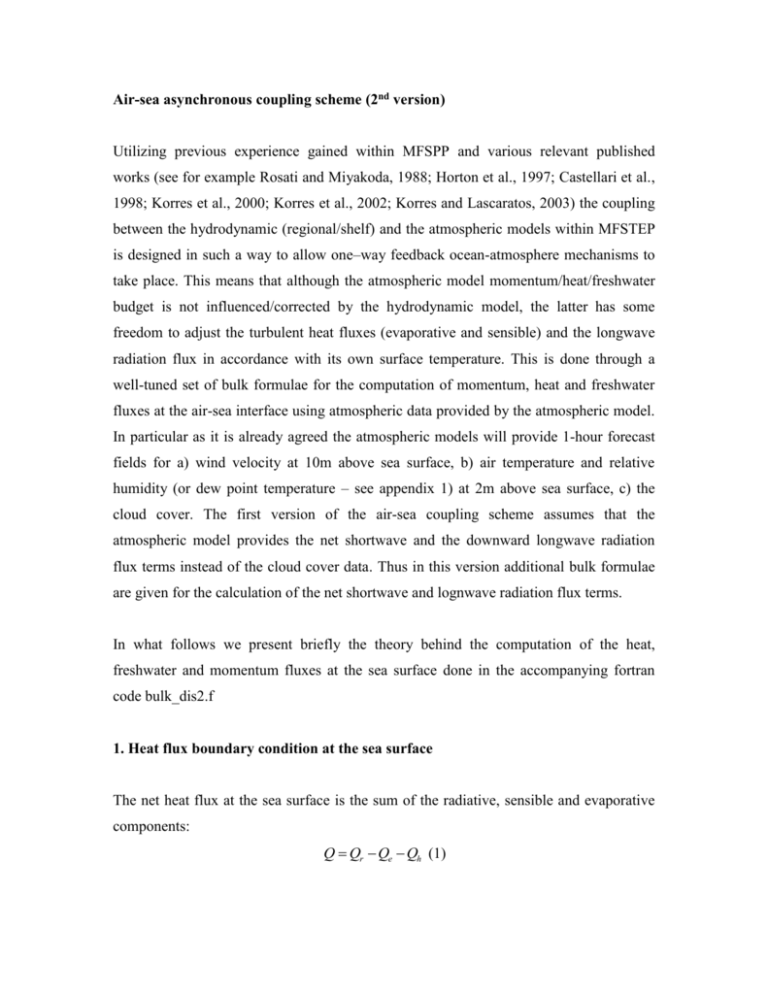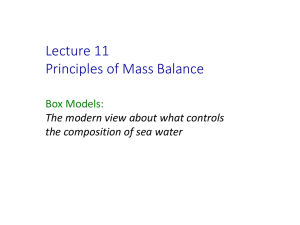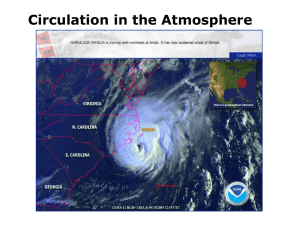ALERMO MFSTEP air-sea coupling documentation
advertisement

Air-sea asynchronous coupling scheme (2nd version) Utilizing previous experience gained within MFSPP and various relevant published works (see for example Rosati and Miyakoda, 1988; Horton et al., 1997; Castellari et al., 1998; Korres et al., 2000; Korres et al., 2002; Korres and Lascaratos, 2003) the coupling between the hydrodynamic (regional/shelf) and the atmospheric models within MFSTEP is designed in such a way to allow one–way feedback ocean-atmosphere mechanisms to take place. This means that although the atmospheric model momentum/heat/freshwater budget is not influenced/corrected by the hydrodynamic model, the latter has some freedom to adjust the turbulent heat fluxes (evaporative and sensible) and the longwave radiation flux in accordance with its own surface temperature. This is done through a well-tuned set of bulk formulae for the computation of momentum, heat and freshwater fluxes at the air-sea interface using atmospheric data provided by the atmospheric model. In particular as it is already agreed the atmospheric models will provide 1-hour forecast fields for a) wind velocity at 10m above sea surface, b) air temperature and relative humidity (or dew point temperature – see appendix 1) at 2m above sea surface, c) the cloud cover. The first version of the air-sea coupling scheme assumes that the atmospheric model provides the net shortwave and the downward longwave radiation flux terms instead of the cloud cover data. Thus in this version additional bulk formulae are given for the calculation of the net shortwave and lognwave radiation flux terms. In what follows we present briefly the theory behind the computation of the heat, freshwater and momentum fluxes at the sea surface done in the accompanying fortran code bulk_dis2.f 1. Heat flux boundary condition at the sea surface The net heat flux at the sea surface is the sum of the radiative, sensible and evaporative components: Q Qr Qe Qh (1) where Q is the net heat flux to the ocean, Qr is the net radiative gain received by the ocean, Qh is the sensible heat flux and finally Qe is the evaporative heat flux. 1.1 Radiative heat flux The radiative term Qr in (1) consists of three components: the shortwave radiative gain received by the ocean Qrs , the net infrared radiation flux emitted by the ocean Qir: Qr Qrs Qir (2) The calculation of the net shortwave radiative gain at the sea surface Qrs is based on Reed formula (Reed, 1977) as already done in Rosati and Miyakoda (1988), for the global ocean and Castellari et al. (1998) for the Mediterranean: Qrs Qstot 1 0.62 C 0.0019 1 (3) In Eq.3 C is the cloud cover (in tenths), is the solar noon altitude in degrees, Qstot is the total solar radiation reaching the ocean surface under clear sky and is the ocean surface albedo. The ocean surface albedo is computed as a function of the sun zenith angle for each grid point from Payne (1972). In cases when Qrs Qstot (overestimation of Qrs due to low cloudiness values) Qrs is truncated to Qstot . The net infrared radiation flux term Qir can be computed according to Bignami formula (Bignami et al., 1995): Qir Ts4 TA4 0.653 0.00535eA 1 0.1762C 2 (4) or according to May formula (May, 1986): Qir TA4 0.4 0.05 eA 4 TA3 Ts TA 1 0.75C 3.4 (5) In formulae (4) and (5) , are the ocean emissivity and the Stefan-Boltzman constant respectively, Ts is the sea surface temperature (predicted by the ocean model), TA is the air temperature at 2 meters above sea surface and eA is the atmospheric vapour pressure which is proportional to the relative humidity i.e: eA r eSAT TA (eSAT is the atmospheric saturation vapour pressure, computed through a polynomial approximation as a function of air temperature, Lowe, 1977). 1.2 Evaporative and sensible heat flux: The evaporative Qe and sensible Qh heat flux terms are calculated by the ocean model using the bulk aerodynamic formulae 0.622 (6) Qe A LV C E W eSAT TS r eSAT TA pA Qh A c p CH W TS TA (7) and the atmospheric data of wind speed W (at 10-meters above sea surface), air temperature TA and relative humidity r (at 2-meters above sea surface) as provided by the atmospheric model at 1-hour intervals. The atmospheric saturation vapour pressure eSAT in (6) is computed through a polynomial approximation as a function of temperature (Lowe, 1977). The specific heat capacity of air c p and the atmospheric pressure at sea level pA are considered as constants. The sea surface temperature Ts used in (6) and (7) is predicted by the hydrodynamic model itself, the density of moist air A is computed by the model as a function of air temperature and relative humidity and finally the latent heat of vaporization LV is calculated as a function of sea surface temperature (Gill, 1982). The turbulent exchange coefficients CE and CH are estimated in terms of air-sea temperature difference and the wind speed taking into account an atmospheric stability index (Kondo parameterisation - Kondo, 1975). 2. Freshwater flux/Virtual Salt flux boundary condition at the sea surface The freshwater flux (FW) or the virtual salt flux (VSF) surface boundary condition (depending on the model configuration) due to evaporation E and precipitation P are given by FW E P (8) VSF E P S (9) where S is the surface salinity predicted by the ocean model. Precipitation rates are provided by the atmospheric model at 1-hour intervals while the evaporation rate is calculated from the evaporative heat flux using E Qe (10) LV 3. Momentum boundary condition at the sea surface The calculation of the wind stress fields is based on the transformation of the 1-hour wind velocity data at 10m above sea surface to x and y components of wind stress following the formula: A CD W W (11) where A is the density of moist air (computed by the ocean model as a function of air temperature and relative humidity) , W is the wind velocity and CD is the drag coefficient. The drag coefficient is calculated as a function of the wind speed and the airsea temperature difference through the polynomial approximation given by Hellerman and Rosenstein (1983). Appendix 1 The relative humidity r (%) can be computed from air temperature and dew point temperature at 2m above sea surface by forming the ratio of the saturation vapor pressure over liquid water at dew point temperature and at air temperature: r es TDC es TAC 100 (12) where TDC , TAC are the dew point temperature and the air temperature in degree Celsius respectively. The saturation vapor pressure over liquid water es (in mb) at temperature T (expressed in degree Celsius) is given by Bolton’s formula (Bolton, 1980): 17.67 T es T 6.112 exp (13) T 243.5 References Bignami, F., Marullo, S., Santoleri, R. and M.E. Schiano, 1995: Longwave radiation budget in the Mediterranean Sea. J. Geophys. Res. 100 (C2), 2501-2514. Bolton, D., 1980: The computation of equivalent potential temperature. Monthly Weather Review, 108, 1046-1053. Castellari, S., N.Pinardi, and K.Leaman, 1998: A model study of air-sea interactions in the Mediterranean Sea. J. of Marine Systems 18, 89-114. Gill., A.E., 1982: Atmosphere-Ocean Dynamics. Academic Press, New York, 662 pp. Hellermann, S., Rosenstein, M., 1983: Normal wind stress over the world ocean with error estimates. J. Phys. Oceanogr. 13, 1093-1104. Horton, C., M.Clifford, J.Schmitz, and L.H.Kantha, 1997: A real-time oceanographic nowcast/forecast system for the Mediterranean Sea. J. Geophys. Res., 102(C11), 2512325156. Kondo, J., 1975: Air-sea bulk transfer coefficients in diabatic conditions. BoundaryLayer Meteorol., 9, 91-112. Korres, G., N.Pinardi and A.Lascaratos, 2000: The ocean response to low frequency interannual atmospheric variability in the Mediterranean Sea. Part I: Sensitivity experiments and energy analysis. Journal of Climate, 13, 705-731. Korres, G., A.Lascaratos, E.Hatziapostolou and P.Katsafados, 2002: Towards an ocean forecasting system for the Aegean Sea. The Global Atmosphere and Ocean System, Vol.8, 191-218. Korres, G. and A.Lascaratos, 2003: A one-way nested eddy resolving model of the Aegean and Levantine basins: Implementation and climatological runs. Annales Geophysicae, 21, 205-220. Lowe, P.R., 1977: An approximating polynomial for the computation of saturation vapor pressure. J. Appl. Meteorol. 16, 100-103. May, P.W., 1986: A brief explanation of Mediterranean heat and momentum flux conditions. NORDA Code 322, NSTL, MS 39529. Reed, R.K., 1977: On estimating insolation over the ocean. J. Phys. Oceanogr. 17, 854871. Rosati, A., Miyakoda, K., 1988: A general circulation model for upper ocean simulation. J. Phys. Oceanogr. 18 (11), 1601-1626.








